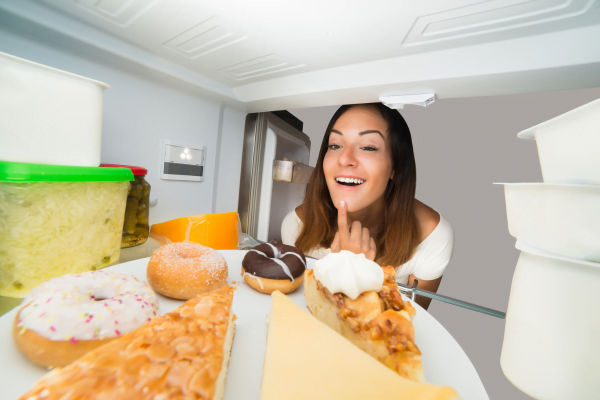We usually associate eating with the taste of delicious food. In reality, the pleasure we achieve from a meal comes from all the senses that enhance our enjoyment through multiple factors. These factors are: the way the food looks, its texture, the sound it makes when we eat it or even the environment in which we eat.
But is it true that we eat with our eyes? Can our sight actually affect what and how much we eat?
It turns out, it certainly can.
The “process of eating”
We all know that eating a meal is a full process. It starts from thinking of what we want to eat, through choosing a restaurant and a group of friends we want to share the meal with, to ordering the meal and finally enjoying the taste of it.
Even the look of a restaurant can have a major impact on whether we perceive a meal as tasty or not.
Imagine a place with a nice, cosy and welcoming ambience, quiet music in the background, nicely decorated tables with clean tablecloths, shiny plates and glasses, warm temperature and nice smell of freshly cooked food.
Now imagine you are waiting for your food and you see a waiter passing by with someone else’s lovely looking meal. I bet your mouth started watering already.
You started imagining what your order will look and taste like. You suddenly feel more hungry and impatient about receiving your meal. And that’s just after seeing appetising food and enjoying the atmosphere.
Eating with our eyes
How does it happen that just the look of food can make such a difference to our experience?
Researchers agree that our perception is typically dominated by what our eyes see. Our eyes evolved in a way that helps us identify nutritious food. This might be why high-fat food images motivate our behaviour more effectively than low-fat options.
The search for food is one of our brain’s most important tasks. It might be that visual hunger, which is our natural desire to look at food, is an evolutionary adaptation. It helped us survive in an environment where food would not be easily available.
By seeing food, immediately followed by its consumption, we created positive associations and learnt to gain pleasure simply from its appearance.
Our eyes communicate with our brain after seeing certain food, which in turn tells us what this food should taste like. This happens through a series of learned and natural responses.
It then may mean that seeing food leads to automatic eating behaviours and increased desire to eat with or without the presence of actual hunger.
Studies show that even despite the flavour being identical, people prefer food with more intense colours, and perceive its taste as stronger. Take peas as an example. The more intense the green colour, the tastier the peas will appear to us.
Orange juice will taste sweeter if its colour is deeper. A similar effect of the colour on our perception can be observed for wine – if we treat white wine with a little bit of red food colouring, it will be perceived as red, even by professional wine tasters.
External influence on our desire for food
But it’s not just about the food itself. This also applies to food packaging.
Packages are designed to affect our decision-making and make us buy food even when we don’t need it. However, it’s not just the impact that food producers and shops have on our decisions. We can all see the influence that social media has on our desire for food. We are bombarded with colourful, appetising, perfectly looking pictures of food, that drives our demand and desire to buy/eat.
Additionally, culinary programmes gain popularity affecting our appetites and eating behaviours. It is now obvious that watching food-related television programs or advertisements can affect the amount and the type of food that we eat.
This can lead to overconsumption, increased gratification and in turn weight gain.
How can we use our eyes to improve our diet and lose weight?
…….Positive visual cues
Luckily, we can also use this to promote healthy eating and slim down.
Using simple unconscious visual cues can support the choice of healthy food for both children and adults.
Children are likely to improve their acceptance of certain vegetables just after regular exposure to the pictures of these vegetables.
Another strategy might be using colours to create a contrast between the food and the plate to improve appetite and intake in case of malnourished hospital patients. It has been proven that such contrast and using a red or blue plate can increase consumption for such patients.
How to eat healthy and lose weight?
Below are the tips on how to avoid overconsumption:
- Limit your exposure to visual food cues – Get up and walk away from your TV during the advert break.
- Try to expose yourself to images of healthy food.
- Avoid watching culinary programmes.
- Never go shopping hungry.
- Create positive associations with healthy food through ordering it in nice places, enjoying the experience with a group of close people, eating it when you are happy.
- Buy fresh food rather than processed versions to avoid temptation through beautiful packaging and producers’ encouraging statements
- Take your time when making a decision.
Seeing food may prompt you to make an automatic decision to buy, even when you are not hungry. Try to take your time.
Take a breath.
Close your eyes and don’t think about tempting food that you’ve just seen.
Focus on what you are feeling and whether you are actually hungry, have a sip of water.
Now re-evaluate.
Yes, we do eat with our eyes, but unlearning certain cues can help us eat healthy and lose weight..





